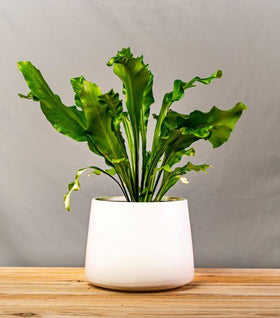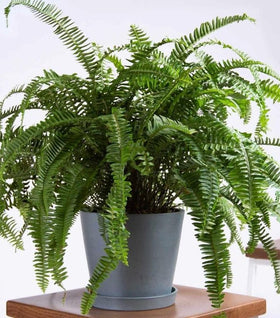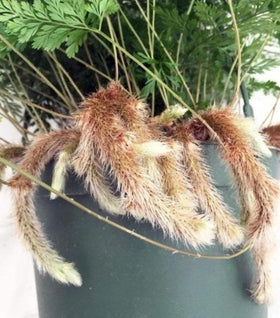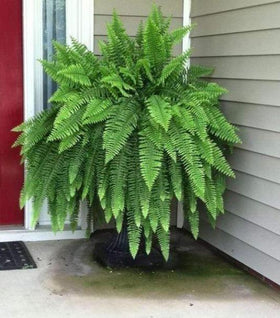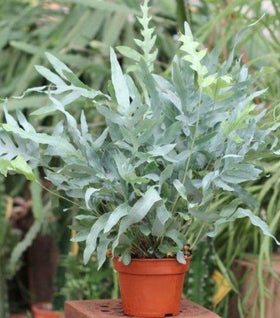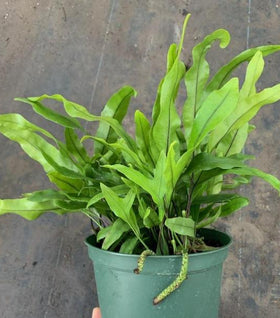Indoor Ferns for Sale Online
Ferns are among the most beautiful house plants grown today. They produce lacy fern fronds and have a classic texture that works well in just about any interior design scheme, from casual to formal. Ferns make the perfect houseplant and have been popular for many years. Ferns are very versatile plants and promote healthy air in our homes by purifying the surrounding air and also promoting humidity too. Ferns are ideal for in the bathroom or kitchen or anywhere low-light levels are found. Ferns are great as a desk plant and will thrive under the fluorescent light.
Types of Indoor Ferns
Staghorn Fern: The Staghorn Fern plant differs from many of the ferns in appearance because of its spear-shaped leaves with wavy edges resembling deer antlers rather than feather or palm-like fronds.
Boston Fern: Boston Ferns find their way into hanging baskets and annual mixed containers for the summer because of their easy-going nature. Boston Ferns are easy to grow and one of the best clean-air plants known.
Birds Nest Fern: The Birds Nest Fern is a fast-growing fern that can be planted in all-purpose potting soil, and because it’s at home in the jungle, it prefers soil that is well-drained but remains moist but not wet.
Victoria Birds Nest Fern: A fantastically easy-to-grow form of the popular Bird’s Nest Fern. This selection has more narrow leaves with crimps along the margins, making them look wavy like lasagna noodles.
Blue Hare's Foot Fern: Blue Hares Foot Fern Plant or Blue Star Fern as it's often called is a beautiful and dramatic fern. Silvery blue fronds produce golden-orange furry rhizomes or "feet" that will circle the pot.
Rabbits Foot Fern: Rabbits Foot Fern is a houseplant named for the furry rhizomes that form and grow above the soil and produce the delicate-looking lacy fronds. In general, this fern likes to stay moist but does not want to sit in water. It does best in low to bright indirect light.
Kangaroo Paw Fern: Kangaroo Paw Fern is a low light houseplant named for the odd-shaped leathery green color fronds that resemble the paws of a kangaroo.
Crocodile Fern: The Crocodile Fern differs from many in appearance because of its spear-like shaped leaves with wavy edges and a unique pattern that resembles the scales of a crocodile rather than feather or palm like fronds. The bright green color brightens up low light areas quite nicely.
Kimberly Queen Fern: The Kimberly Queen Fern or the Australian Sword Fern is a more compact fern than the Boston or Dallas fern. Great for hanging baskets with its tightly joined fronds. Very Easy to Grow as an Indoor plant. It does equally well on a shaded outdoor patio or balcony.
Asparagus Ferns: This is a diverse sub-group of the fern family. They are small in stature but big in impact. Asparagus ferns have been used in mixed containers and hanging baskets for many years. They are now becoming very popular again, but this time they are being used by themselves.
We're happy to see these little gems working their way to the forefront of the plant community. While not actual members of the fern family, they are classified by most as ferns. We, as are most gardeners, are ok with calling this plant fern.
The "Original Asparagus fern" is very easy to grow and has quite an interesting texture. The Foxtail Asparagus Fern is more upright and compact than the Original, features erect spear-like stems and bright pale green leaves. Plumosa Asparagus Fern is a fluffy, fern that produces glossy green-colored foliage. Even though the foliage is thin and needle-like, it adds a very dense, arching look to planters and mixed containers. Ming Asparagus Fern has exciting foliage and flowers.
Growing Ferns as Houseplants
Ferns are relatively easy to grow indoors. Ferns do not like drafts, dry air, or low humidity levels. There are large groups of tropical and subtropical ferns, and most are happy as houseplants throughout the United States.
Soil: Most ferns are indigenous to forests or woodlands. Ferns have tender, delicate roots that have adapted to the light forest soil, which is rich in organic matter. The right potting soil must be well-drained so that the roots never get waterlogged.
A fertile organic soil such as Ocean Forest Organic Potting Mix is our go-to soil for ferns. The soil should never be allowed to dry out, which may mean watering the plant a little every single day or so in a warm, dry atmosphere such as winter in most homes.
Light: Even though ferns grow in moist shady places like forest floors, this does not mean that they require low light. Typically the sunlight level of lush forests is considered to be dappled light. If the light level in the home is too low, you will see reduced growth and yellowing fronds on ferns.
Position your ferns near an east or west-facing window. This allows your fern plants to receive morning or late afternoon sun. Keep ferns away from strong sunlight, especially during the summer months. Direct sunlight will make them drop their leaves or turn their yellow.
Fertilizer: Feed ferns in the summertime every two to four weeks with a liquid fertilizer mixed to half-strength. Overfertilization can damage the tender roots of ferns.
A secret tip from houseplant growers who are very successful at growing ferns is to mix a few drops of liquid fertilizer into a spray bottle and lightly mist the foliage of the ferns every few days. Don't overdo it. A little fertilizer goes a long way in a mister.
Stop feeding your ferns during the winter months, allow them to rest. To keep the air around your ferns moist, mist them often or place the pot into a saucer with gravel. The water running out of the pot when you water will keep the air around the fern more humid as it evaporates.
Repotting Indoor Ferns
Indoor ferns don't mind being pot-bound and can go up to two years before repotting. When repotting ferns, it's perfectly alright to divide the plant into big clumps. Be sure to take multiple underground roots when dividing larger ferns.
Place the divided plants into similar-sized pots to retain the tight growth habit. Mist often afterward to help the ferns to recover from any shock.
Ferns as Clean Air Plants
Did you know that ferns remove toxic chemicals from indoor spaces? Boston ferns and other fern plants improve the air quality of indoor environments by absorbing formaldehyde, benzene, trichloroethylene, xylene, and toluene. In the 1970s and 1980s, NASA conducted in-depth studies on indoor air contamination that had become a problem on the Skylab space station.
If you’re thinking about purchasing an Indoor fern Plant for your home or office interior, consider Woodie’s Approved collection of Indoor Fern Plants from Garden Goods Direct. As America’s number one online garden center, we offer a broad selection of houseplants and indoor trees, including many types of Ferns. We also provide advice from our helpful and friendly customer service plant experts that you may need to keep your plants healthy.
From Aglaonema to ZZ Plants, we have a vast range of house plants, all available from our online store. Buy your Indoor Ferns online from Garden Goods Direct today! We care about the condition that your plant arrived. 99.9% of our customers have let us know that their plant arrived in perfect condition. Please let us know if your plant does not so we can correct the deficiency.

